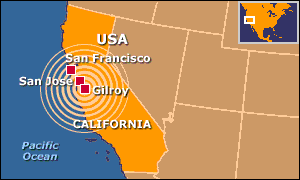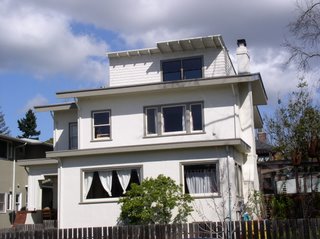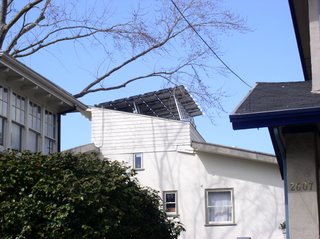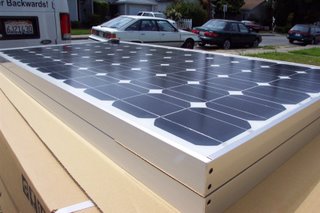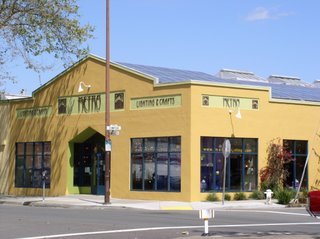 Metro Lighting and Crafts Store with solar, Berkeley, CA
Metro Lighting and Crafts Store with solar, Berkeley, CA
Hey solarDwellers,
Welcome to my first installment of interviews I plan to do, talking to local people and businesses in the neighborhood that have taken that awesome, liberating and green step of going solar.
One thing I believe is that solar on roofs can be contagious as more people get curious when they see neighbors making that solar choice. The whole "tipping" point meme. I wanted a way to go further than seeing and posting photos of a new solar PV system, or a large roof with a bigger-than-average PV system in the S.F. Bay Area. So, I decided to talk to and get the first-hand experience of people living beneath those solar roofs, and let them talk about how they feel about solar, and if it has been positive both environmentally and economically for them.
So, for my first "solar-spotlight interview", I would like to highlight a
company called
Metro Lighting, in Berkeley, CA that makes artisan lamp and lighting fixtures. When I first drove by their large grid of solar panels perched on their retail store roof, I thought, "Now there's a nice-sized PV system." It really made their "green building" stand out among the other industrial buildings on that block. And when I got closer and saw all those display fixtures inside, most of which the owners have diligently switched over to the energy-efficient, compact fluorescent kind, I immediately understood how that large electricity bill was probably crying out to the owners for some sleek solar panels up on the roof.
From their website, a little bit about the owners and their hand-crafted lamp designs: "Metro Lighting & Crafts was founded in 1993 by Lawrence Grown, and began as a restoration company for antique lighting fixtures. In time, Lawrence and his wife, Christa Rybczynski, who both hold degrees in Architecture, began using their
knowledge of lighting and architectural history to create new designs,
inspired and informed by Art Nouveau and Craftsman aesthetics."
Here's a side view of the roof with 100+ panels:

I spoke with Lawrence and Christa at their store and by e-mail about their year-old, commercial solar PV system as recorded in the following Q&A with them:
solarDweller: How long have you had your system?
Metro Lighting: It was one year last October/November 2005.
solarDweller: What size is your system and what percentage of your
electricity use was it designed to cover?
Metro Lighting: 19 kW. It was designed to cover 60% of our
store's electricity use.
solarDweller: How does its output compare to what your installer
predicted?
Metro Lighting: We are covering at least 60%, maybe even up to 70% of our electricity use.
solarDweller: How does your bill compare to what it was before?
Metro Lighting: It had been $800 to $900/month before solar. For
last year it averaged only $300/month.
solarDweller: How long did your installer estimate it will take
for the system to pay for itself?
Metro Lighting: About 5-6 years
solarDweller: How did you get the idea to put solar on?
Metro Lighting: The monthly bill was a constant reminder of how
much energy we were using. We tell our kids to turn off the
lights when not in use at home, but we need to have our display
fixtures lit all day. I guess it was just a matter of time
until we felt we could afford the investment.
solarDweller: What was your principal motivation? Ratio of
economics/environmental benefit. (50/50? 30/70? 70/30?)
Metro Lighting: About half for economics and half for the environment.
solarDweller: What was the biggest barrier/worry to making the
decision to purchase your solar PV system?
Metro Lighting: The initial outlay of cash, and the fact that we
don't own the building.
solarDweller: If you don't own your building, what did you have to
do to convince the owners? (
Gordon Commercial Real Estate)
Metro Lighting: It was much simpler than I had thought. The
owners were also interested right away, we just needed to work
out the details. We wrote an addendum to our lease saying that
we owned the system and could choose to take it with us if we
leave. The installer is liable for any roofing issues.
solarDweller: How do you feel now that you have it?
Metro Lighting: Pleased and proud.
solarDweller: Have you thought of marketing yourself as a green
business to differentiate yourself from competition?
Metro Lighting: We have applied to the Alameda County Green Business Certification program, but they have a big backlog. I'm not sure when we'll be able to officially call Metro Lighting an Alameda County Certified Green Business, but that will be an exciting day. We also have a new line of compact fluorescent lighting fixtures for further energy conservation. We've swapped out many of our display bulbs from 25 watt incandescent to 5 watt screw-in compact fluorescents as well. I'm hoping when it gets sunny that our meter will spend more time running backwards.
solarDweller: Do many people notice or ask you about your solar PV
system?
Metro Lighting: Not that many people have mentioned the system, actually. At first there were a lot of comments, but not many anymore. That's fine, really. We want to do the right thing, but we are not in the solar business, and we don't mind sticking to the work at hand of designing, building and selling quality lighting.
That pretty much said it all, and I was glad to get such positive feedback and feelings about solar from a true solar PV owner. I liked the short payback period, and the fact they FEEL so good about having that solar there helping them make green energy for their business. I was also pleasantly surprised to hear that what could be seen as the big hurdle of convincing Gordon Commercial to let them do solar, that it was just a matter of adding language to the lease and getting the guarantee from the solar installer.
It's great to see a small business doing "the right thing" in the neighborhood, carrying out their artistic endeavors while keeping our air that much greener and cleaner! And, don't worry: their neighbors will get that solar envy, and hopefully follow the great example being set by Metro Lighting of Berkeley. Check out their website www.metrolighting.com the next time you need some nice lighting solutions. You'll feel good about your green purchase!
--the solarDweller
And now, for the really solar curious . . .
Some pictures of the inverter AC output and DC-AC calculations:
Their system runs off 5 Sharp 3500 watt Sunvista inverters, which means their theoretical maximum AC output is 17,500 watts or 17.5kW. Remember, these are fed by 19,000 watts or 19kW of DC power from the panels before the electricity gets converted to AC by those inverters. Electricity gets "lost" as it passes through the conversion process in the inverter. Lawrence and Christa can check out the system's AC production at any time by looking at the following displays, one for each inverter:

And a close-up of one of the displays:
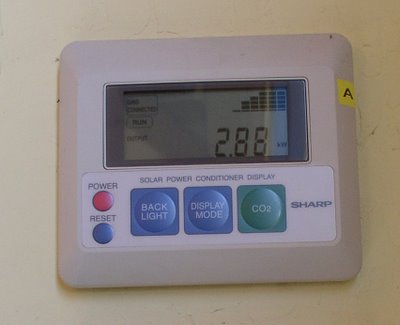
The amount of DC going into that inverter from the DC panels started at 3.8 kW (19kW total panels/5 inverters), but the monitor in the photo, which we checked at high noon(solar time) on a sunny day, reads only 2.88 kW AC, not the "theoretical" max AC output from the Sunvista 3500 inverter of 3.5 kW. Why? Well, the old reality that you "lose" some of the electricity as it travels from the panels to the inverter, and then again when it passes through the inverter. The important number when you're buying a system is to try to figure the "real world" efficiency, or what percentage of the total DC rating of your panels gets converted into the AC output as it comes out of the inverter.
2.88 kW AC output / 3.8 kW of DC panels = 76%
You buy 3.8 kW worth of DC panels, and you get 2.88 kW of usable AC out of them. This is just the reality of efficiency loss when converting DC to AC. Many people OVERESTIMATE how much AC electricity their DC panels will produce. It's an easy mistake. If you buy 3.8 kW of panels and just multiply by an inverter which is 92% efficient, you'll overestimate your AC: 3.8 * .92 = 3.5 kW. To account for the total efficiency loss in the wiring, dust on the panels, etc, it's safer to count on an efficiency of 75-80% from the panels' total DC rating. I usually go with 77%, assuming direct sun, panels tilted at latitude and no significant shading. So, in the case above, just take your 3.8 kW of panels going into one inverter and multiply:
3.8 kW * .77 = 2.92 kW AC output, which is very close to the 2.88 kW "real-world" reading we saw in the photo of the single monitor above.
Use the lucky "77" efficiency number when you try to estimate the output of your solar panels and you'll come pretty darn close to reality. It's better to be pleasantly surprised that your system produces a little more than your conservative estimate than to be disappointed about what was an overly-optimistic efficiency estimate.
Hasta la próxima, solar people, and hope this post was useful!
Categories: solar, solar+power, solar+energy, renewable, alternative+energy, sustainable, tips, calculations, solarsightings, psychologymarketing


